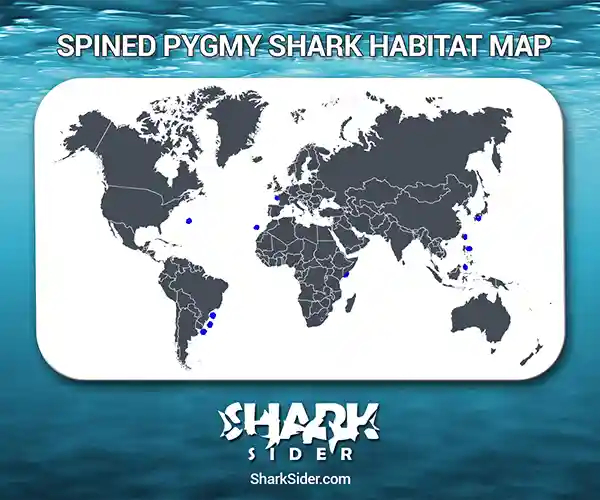The spined pygmy shark is a small species of dogfish shark found distributed across all major oceans.
Belonging to the genus Squaliolus, in the family Dalatiidae, this shark was first described in 1912 by two American ichthyologists Hugh McCormick Smith and Lewis Radcliffe. They published their research in the Proceedings of the United States National Museum, a scientific journal. Their findings were based on two specimens captured in Batangas Bay in the Philippines. One of the two specimens, a 5.9-inch long adult male became the type specimen for the species.
Spined Pygmy Shark Scientific Classification |
|
| Kingdom | Animalia |
| Phylum | Chordata |
| Class | Chondrichthyes |
| Order | Squaliformes |
| Family | Dalatiidae |
| Genus | Squaliolus |
| Scientific Name: | Squaliolus laticaudus |
Description
One of the smallest species of sharks alive after the dwarf lanternshark, the females larger in size measure 11 inches. In comparison, the males are 8.7 inches long.
Their dark brown or black dorsal side leads to fin margins with light coloration.
This shark has a long, spindle-shaped body with a conical or somewhat pointed snout. Their head consists of large eyes with a straight orbital rim and a broadly angled upper eyelid. A short skin flap covers each of their nostrils.
Thin, smooth lips circle their mouth. The upper and lower jaws have 22-31 and 16-21 tooth rows, respectively. While the upper teeth are narrow with smooth edges and a solo upright cusp, the lower teeth are smooth-edged, with a knife-like cusp with broad and interlocked bases.
Five pairs of equal-sized gill slits with small openings are found on the sides of their head.
They have light-emitting photophores on their ventral surface, ranging from the tip of their snout to the area around the eyes.
They have a sexually dimorphic spine on their first dorsal fin, which is absent in the second dorsal fin. In fact, in males, the spine appears prominent and exposed. However, in the female spined pygmy sharks, the spines aren’t directly visible but enclosed within the skin.
While the tiny first dorsal fin originates over the pectoral fin trailing margin, the second dorsal fin has a more extended base and originates behind the pelvic fin bases. The rear margin of the short and triangular pectoral fins is curved. There is the presence of elongated pelvic fins, while the anal fins remain absent in this shark.
They have slender and laterally expanded caudal peduncles that act as weak keels to help them retain balance while swimming. The upper and lower lobes of their broad, paddle-shaped caudal fin look similar in size and shape.
Their skin has flat, blocky dermal denticles (teeth like hard outer covering in sharks). This shark has one of the fewest vertebrae, just 60, on average, much lower compared to other sharks that have around 170-187 of them.
Where do they live
Map Of The Spined Pygmy Shark’s Habitat

These sharks are distributed across all major oceans, at depths of 660–1,640 feet where sufficient sunlight enters. Its numbers range from the Atlantic Ocean (Bermuda, the U.S., Suriname, southern Brazil, northern Argentina, northern France, Cape Verde, Madeira, and the Azores), the Indian Ocean (Somalia), Pacific Ocean (southern Japan, Taiwan, and the Philippines). In the Atlantic Ocean, they are mostly found along the Bermuda Islands, the United States, as well as parts of South America including northern Argentina, southern Brazil, and Suriname in the west. Whereas, in the east, they occupy parts of northern France as well as Azores, Cape Verde, and Madeira in Portugal.
They inhabit areas of high biological productivity such as continental and insular slopes, island land masses, and outer shelves.
Behavior
Dietary
The spined pygmy shark usually feeds on bony fishes including the dragonfish, bristlemouth, and lanternfish, as well as squids belonging to the Histioteuthis and Chiroteuthis genus.
While feeding, these sharks follow diel vertical migrations, remaining at a depth of 500m during the day and moving up to 200 m at night.
Reproductory
A viviparous mode of reproduction is followed by these sharks, where the developing embryos sustain off a yolk sac instead of a placental connection with the mother. Adult females possess a pair of functional ovaries, each of which may contain up to 12 mature eggs, though the resultant litter size is comparatively smaller. Four about-to-be-born pups were present in one such instance inside a female spined pygmy shark caught in 1999 off southern Brazil. These pips measure 3.5-3.9 inches at the time of their birth.
Males reach sexual maturity when they are 5.9 in long, whereas females mature at 6.7–7.9 inches.
Adaptations
The photophores on their undersides may help them in counter-illumination. Here, the shark camouflages its ventral body surface to adapt to the daylight coming from above. This helps it to disguise its silhouette from predators swimming below them.
Interactions with humans
The small size of these sharks makes them unsuitable for any commercial value. Although they are sometimes incidentally caught as bycatch of trawl fisheries, they are released back into the ocean.
Its wide distribution and habitat and absence of any prominent threat to its numbers have resulted in the IUCN listing it as a ‘Least Concern’ species.
There are no conservation methods currently underway for the protection of this species.
